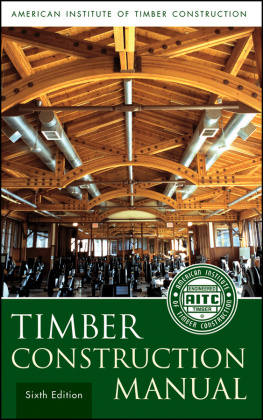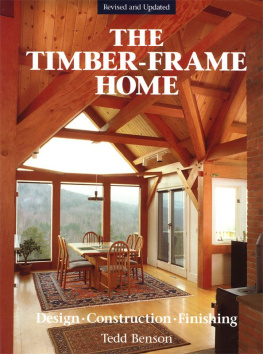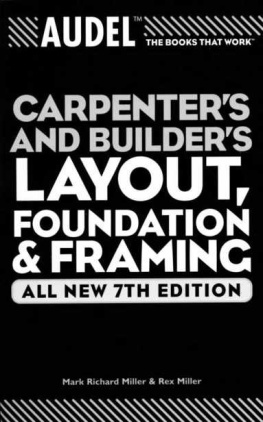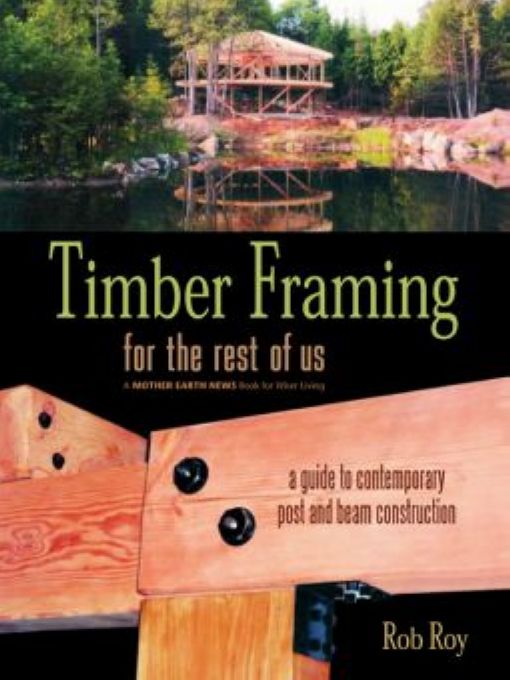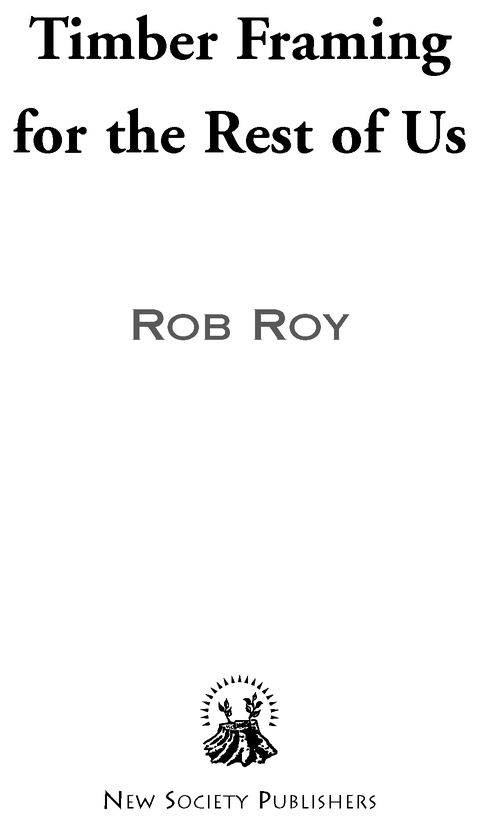Table of Contents
Advance Praise for Timer Framing for the Rest of Us
With more than thirty years of hands-on experience, Rob Roy brings solid insight and understanding of the importance of timber framing to all aspects of natural building. This eminently readable, beautifully illustrated book offers both practical advice and personal experience.
ROBYN GRIGGS LAWRENCE, Editor-in-Chief, Natural Home magazine
If you want to build a home or barn without spending a fortune, you should read this book. Modern timber framing techniques are easy to learn and perfect for building with straw bales, cordwood masonry, cob, structural insulated panels (SIPs) or local timber. The chapter about low-cost chainsaw mills for cutting your own lumber, alone, is worth the price of the book.
CHERYL LONG, Editor-in-Chief, Mother Earth News
In Timber Framing for the Rest of Us, Rob continues his good work of stocking the shelves of the owner-builders library. His books provide accessible information and inspiration to a new generation of hands-on homeowners.
MARK KLEIN, Gimme Shelter Construction, Amherst, WI
This is a wonderful reference for anyone considering timber frame construction, and is somewhat intimidated by the exactness of the craft. Rob Roy has blended this beautiful time-honored technique with state-of-the-art joinery components to make timber framing available to all. However, theres more than just nuts and bolts to this book, Rob also provides useful information on frame design, structural load calculations, lumber procurement and more. If youre looking for an alternative to conventional construction but arent quite ready to tackle a traditional timber frame this books for you.
DON OSBY, builder and art director of BackHome Magazine
Rob Roy provides a wealth of basic information, tools and techniques for heavy timber construction, employing bolts and ingenuity. He offers a comprehensive and comprehendible alternative to traditional timber framing for people with a wide range of skills and experiences, all delivered in the lively and charming style we have come to expect from his work in other areas.
JOEL C. McCARTY, Timber Framers Guild
Books for Wiser Living from Mother Earth News
Today, more than ever before, our society is seeking ways to live more conscientiously. To help bring you the very best inspiration and information about greener, more-sustainable lifestyles, New Society Publishers has joined forces with Mother Earth News. For more than 30 years, Mother Earth has been North Americas Original Guide to Living Wisely, creating books and magazines for people with a passion for self-reliance and a desire to live in harmony with nature. Across the countryside and in our cities, New Society Publishers and Mother Earth News are leading the way to a wiser, more sustainable world.
Dedication
To George Holden, Highland farmer, artist and friend. Thanks for showing me that we can do most anything, if we just put our minds to it.
Acknowledgments
A LOT OF PEOPLE OVER A LONG PERIOD OF TIME helped make this book possible. I would like to thank:
Geoff Huggins, Mark Powers, Joe Zinni, Larry Schuth, Jim Juczak, Richard Flatau, Chris Ryan, Jim Washburn, George Stuart, Ki Light, contractors Russell Pray and John Light, Steve Sugar and Eileen Hogan, and Terry at K Bay on Hawaiis Big Island for sharing their timber framing experiences.
Will Beemer of Heartwood Building School for timely materials and for introducing me to the Timber Framers Guild.
Timber framer and author Steve Chappell for permission to use three illustrations from his book, A Timber Framers Workshop, and for cheerfully answering questions.
Bob Samuelson for great advice on obtaining salvaged timbers.
Marie Cyburt Taluba for a drawing she did back in 1977 for my first book, a drawing used again here.
Doug Anderson of Winter Panel Corporation in Vermont for good information about stressed-skin and structural insulated panels.
Darin Roy, Rohan Roy, Anna Milburn-Lauer, Bruce Kilgore, Diane Lukaris, Stephanie Bayan, Doug Kerr, John Light, Peter Allen and Dawn Palmer for help with the new Earthwood sunroom, without which the important Chapter Five would not exist.
Richard R. Chapman at Simpson Strong-Tie Company, Inc.; Bette Gahres at Sterling Publishing Co., Inc.; and Margaret M. Leddin of the International Code Council for permissions to use copyrighted illustrations and tables.
Daniel Rimann, P.E., for reviewing Chapter Two on Timber Frame Structure and Appendix B on Stress Load Calculations. His corrections and suggestions were valuable, but any errors left behind are mine alone.
Bob Curnings at Prazi USA for supplying a picture of their Beam Cutter attachment for circular saws.
Long-time friend and BackHome Magazine editor Richard Freudenberger for his fine manuscript editing and permission to use the picture on page 57. (Isnt he a good-looking guy?) Its been great to finally work with Richard on a book-length manuscript.
The New Society gang is a pleasure to work with, even when crises occur. Thanks to:
Editor-in-Chief Chris Plant for his faith in the book.
Ingrid Witvoet for coordinating the text editing and Greg Green for his usual fine art editing.
Diane McIntosh for the cover design and Jeremy Drought for the interior layout.
Finally, and not least, loving thanks to my wife and building co-conspirator, Jaki, for her patience and her valuable help on photography, manuscript preparation, and with finding missing pictures. Now, as I write on February 16th, 2004, the galleys are proofed and this page is my last act on this book. Jaki will be getting at least some of her table surfaces back until the next book (which begins next week.)
Rob Roy
Earthwood
West Chazy, New York
Introduction
Timber Framing for the Rest of Us. Us implies Them, or They or Not Us. And who are these others? They are no less than the skilled timber-framers, using time-tested methods of creating beautiful, strong, and enduring buildings throughout the world. At its best, timber framing done by traditional methods of joinery yields a quality of construction that spans the range from craft to art.
The use of timber-framing joinery, such as scarf, mortise-and-tenon, and rabbet joints, evolved during a time before metal fasteners were available, and its traditional use continued when metal spikes would have been expensive. Quality wood-on-wood timber framing continues to this day, and is a joy to see. There are plenty of good books to show how the work is done, and building schools that will teach the owner-builder these skills. Books are listed in the Bibliography, and schools and other resources are listed in Appendix C.
I have the highest admiration for these traditional builders. A good friend, who died much too young, took great pride in restoring historic timber frame buildings in Northern New York, often working to 1/64-inch (0.39 millimeter) tolerance. But the reality is that most timber framing is not done in the old-fashioned traditional way with wooden pegs, mortise-and-tenon joints, and the like. With the advent of relatively inexpensive mechanical fasteners, most builders contractors and owner-builders alike rely on other methods of joining, using things such as truss plates, screws and bolts, pole-barn nails, and even gravity. The problem is that there is a shortage of information about joining heavy timbers by these methods. Most construction manuals are quite good about describing the joining of two-by lumber usually 1 inches (3.81 centimeters) thick nowadays and thats the extent of it. Chapter 1 speaks about traditional timber framing and the kind that this book is about.










